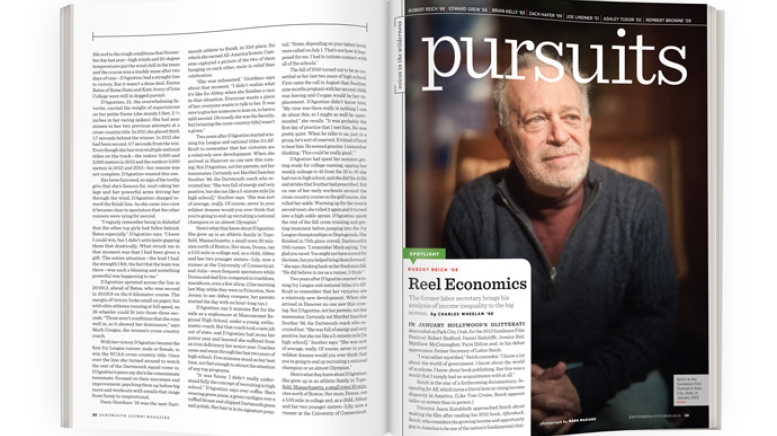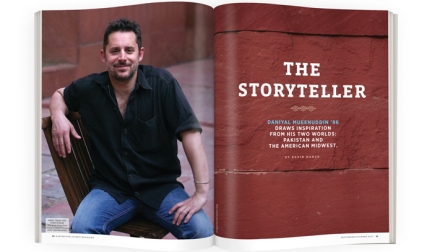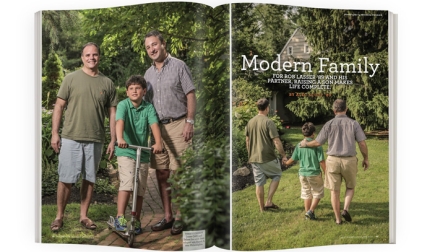Robert Reich ’68
Reel Economics
In January Hollywood’s glitterati descended on Park City, Utah, for the 2013 Sundance Film Festival: Robert Redford, Daniel Radcliffe, Jessica Biel, Matthew McConaughey, Paris Hilton and, in his debut appearance, former Secretary of Labor Reich.
“I was rather mystified,” Reich concedes. “I know a lot about the world of government. I know about the world of academe. I know about book publishing. But this was a world that I simply had no acquaintance with at all.”
Reich is the star of a forthcoming documentary, Inequality for All, which turns a literal lens on rising income disparity in America. (Like Tom Cruise, Reich appears taller on screen than in person.)
Director Jason Kornbluth approached Reich about making the film after reading his 2010 book, Aftershock. Reich, who considers the growing income and opportunity gap in America to be one of the nation’s fundamental challenges, was keen to talk about the issue. “I’ve tried everything else and don’t feel like I’ve made much of a dent,” he says. “Film is the last frontier.”
At Sundance Inequality for All was awarded a special jury prize in the U.S. documentary competition. Reich joined the filmmakers in Park City for the festival as they sought a distributor for the film. After what Reich describes as “an intense week” of talking to industry insiders, Radius TWC, a division of the Weinstein Co., acquired the distribution rights. The documentary will premiere in select cities in September.
Those expecting Michael Moore-like gimmicks and “gotcha” interviews with villainous CEOs will be disappointed (or relieved). Instead, the documentary gives Reich a platform as he interprets the complex social and economic forces at play: stagnant middle class wages, the decline of unions, educational failures, money in politics, globalization, technology and so on.
Many of the scenes are filmed in the classroom at the University of California, Berkeley, where Reich is a professor of public policy. At every point in the film, including a clever opening sequence in a Mini Cooper that plays on Reich’s diminutive size, Reich is front and center. “I was surprised that the director wanted as much of my own biography in the film as he wanted,” Reich says.
The most affecting parts of the film document Reich’s lifelong commitment to social change. Even those who know the story of Reich’s first meeting with a fellow Rhodes Scholar and future president as they crossed the Atlantic together for Oxford will appreciate Reich’s retelling of that fateful encounter. He recalls being sequestered in his cabin, horribly seasick. “And then there was a knock on the door and this fellow was there, this kind of tall gangly Southerner,” says Reich. “He had chicken soup in one hand and crackers in the other and he said, ‘I hear you aren’t feeling too well. I thought these might help. My name is Bill Clinton.’ ”
In both the film and in person, Reich comes across as wistful in assessing the impact of his career efforts, particularly his stint in the Clinton administration. “I was so frustrated by our inability to make more progress more quickly that I think I became sort of a bit too predictable,” he says. (Others are less critical. Time magazine picked Reich as one of the 10 best U.S. Cabinet secretaries of the 20th century, along with the likes of George Marshall and Robert Kennedy.)
Will Inequality for All shape Americans’ evolving and contentious views about income inequality? Perhaps, though it is hard to imagine today’s polarized polity grappling meaningfully with such a politically fraught issue.
In any event, the film pays homage to Reich’s tireless dedication to public service. One is left thinking that if the film does not change American attitudes, he will almost certainly try something else. Music video?
—Charlie Wheelan ’88
(Wheelan is a senior lecturer and policy fellow at the Rockefeller Center at Dartmouth. His most recent book, The Centrist Manifesto, calls for a new political party of the middle.)
Edward Grew ’66
Rock Star
Grew has been involved in the discovery of 13 minerals during his career—and now his own name is etched in the mineral record. Two newly discovered minerals bear the name of the geologist, who has been studying minerals for more than 60 years. Edgrewite and hydroxyledgrewite—first found as tiny crystals smaller than the period at the end of this sentence—were discovered in 2011 by a pair of Russian geologists near Mount Elbrus in Russia. Grew, former associate editor of American Mineralogist, first began working with the Russians a few years ago as he helped them prepare papers for publication. The pair chose the mineral names to recognize Grew’s work with their colleagues throughout his career, beginning in 1972 when he wintered at a Soviet base in Antarctica called Molodezhnaya Station. “It’s a very great honor, and something I had literally dreamed about for many years,” he says. The minerals are related to compounds used to make cement, and have potential uses in industrial applications.
Grew says he first became interested in minerals as a young boy. He remembers collecting the rare minerals containing boron and beryllium on his own while growing up in Andover, Massachusetts. He went on to study geology at Dartmouth, and now he’s in his 28th year as a research professor in the earth sciences department at the University of Maine. His focus remains on the role boron and beryllium play in the changes rocks undergo at high temperatures and pressures in the earth’s crust. His research has taken him all over the globe, including nine expeditions to Antarctica.
—Svati Narula ’13
Marina Shkuratov ’15 • Brian Kelly ’83 • Zach Hafer ’99
Boston Legal
Kelly had a good excuse for missing his 30th reunion: As an assistant U.S. attorney in Boston he was busy prosecuting crime boss Whitey Bulger in one of the most publicized trials in the city’s history. Kelly says his love of the law was inspired by former government professor Vincent Starzinger.
Although Kelly began investigating the South Boston gangster in the 1990s and tried related cases, he admits to doubts that Bulger, a fugitive for 16 years, would ever be found. “After I got the call at home that they had him, I couldn’t sleep, so I went right to the office,” he says. “We had mountains of materials at the ready, but that had to be organized and synthesized so it could be presented to a jury in a logical, streamlined way.” His legal team included Hafer, an assistant U.S. attorney formerly focused on drug cases, and Shkuratov, a spring-term intern. The Dartmouth connection “provided some levity” during their long hours, Kelly says. “It’s interesting we represent 16-year intervals.”
The prosecution rested its case shortly before DAM went to press, with 32 charges pending against Bulger.
—Lisa Furlong
Joe Lindner ’51
Chasing the Best Burger
“There’s a lot more to a hamburger than a piece of meat,” says Lindner. “It’s gotta have fresh, crisp lettuce, a ripe tomato—and the bun is 50 percent of a hamburger.” He should know: In the past three years Lindner and his wife, Doris, have traveled to all 50 states and the District of Columbia to sample America’s best burgers, as vetted by USA Today in its 2010 list of “51 Great Burger Joints.”
That same year the Lindners began checking the joints off during a road trip to Colorado to visit their daughter that included stops at Denver’s Park Burger as well as the listed establishments in Kansas, Missouri and Tennessee. Driving all over the country to visit friends and enjoy America’s favorite sandwich, the couple has encountered variations such as pretzel dough buns and beef topped with an egg or peanut butter. “We didn’t just eat hamburgers; we tasted America and it was good,” he says. “It really was.”
At the end of April, daughter Laura Sankey ’86, with husband Kevin ’86 and their three children, joined the Lindners in Waimea, Hawaii, to complete their checklist at the Village Burger Kamuela. “Out of this world,” Lindner says of its offering. —Lauren Vespoli ’13
Joe’s Top 5 Burgers:
Village Burger Kamuela
Waimea, HI
Local beef with pineapple slaw
Django
Des Moines, IA
Juicy beef topped with gorgonzola
Ray’s Hell Burger
Arlington, VA
Fresh beef, flavorful
Diablos
Flagstaff, AZ
“DB” branded on burger, served on English muffin
Park Burger
Denver
Fresh bun and juicy beef
Ashley Tudor ’02
Paleo Woman
Tudor is betting the future of health on a prehistoric diet. The health guru—and avid hunter—is among a growing number of nutritionists and athletes inspired by “Paleolithic eating:” abandoning grains, dairy and sugar in favor of meat, fish and vegetables to approximate what humans relied on for energy before the agricultural revolution. Her book Sweet Potato Power, released last spring, puts a twist on traditional concepts of the Paleo diet by advocating for “smart carbs” such as sweet potatoes, which Tudor calls “a powerful ally in our efforts to eat primal in a modern world.”
The San Francisco resident was named one of the city’s “Top Innovators in Health” by the mayor in 2010. Her passion for nutrition and the Paleo diet led to her lifestyle as an active hunter. “I love being connected to the ingredients that I use in my cooking, and hunting became a way that I could find the cleanest meat,” Tudor said in a 2012 interview with CBS San Francisco. As if becoming a field-to-table chef wasn’t enough, Tudor also found artistic inspiration. Her sculptures—bronze replicas of animal skulls cast into European-style mounts—have garnered plenty of attention from the art world, the hunting community and mainstream media outlets. Each piece takes about three months to create. Melding the natural and organic with distinctly contemporary materials isn’t easy, but the end result reflects Tudor’s effort to inject primal aesthetics into modern living.
—Svati Narula ’13
Rembert Browne ’09
Rembert Explains
This acclaimed blogger has a unique take on popular culture—one that Ebony magazine says makes him one of the “7 Young Black Writers You Should Know.” Browne shares his upbeat, quirky perspective at Grantland through a signature March Madness-style bracket approach he has used to determine the best Jay-Z song titles and through his blog Rembert Explains the ’90s, running commentaries interspersed with video clips (most recently his commentary on Will Smith’s “Gettin’ Jiggy Wit It”).
The former columnist for The Dartmouth Mirror magazine says he writes with his friends and comedian Dave Chappelle in mind. “If it’s something that these 12 people who have various different interests would be intrigued or entertained by, then I think I have something that will work for the greater public,” he says. Browne’s approach has thrived in social media, as evidenced by the 43,000-plus followers of his Twitter feed, which Time magazine recently declared one of the best.
In his latest venture for Grantland—Rembert Explains America—Browne set out in June to discover the wonders of the contiguous 48 states in a rental car. In the debut entry he details how, eight New York City blocks into the journey, he backed into another car while a policeman looked on. In the almost-daily blog he mixes photos shot along the way (which might help explain his accident record) with milepost observations and recollections of growing up. “You need to take breaks from technology and the Internet sometimes, because it can just rot away at your soul,” he says. —Lauren Vespoli ’13




